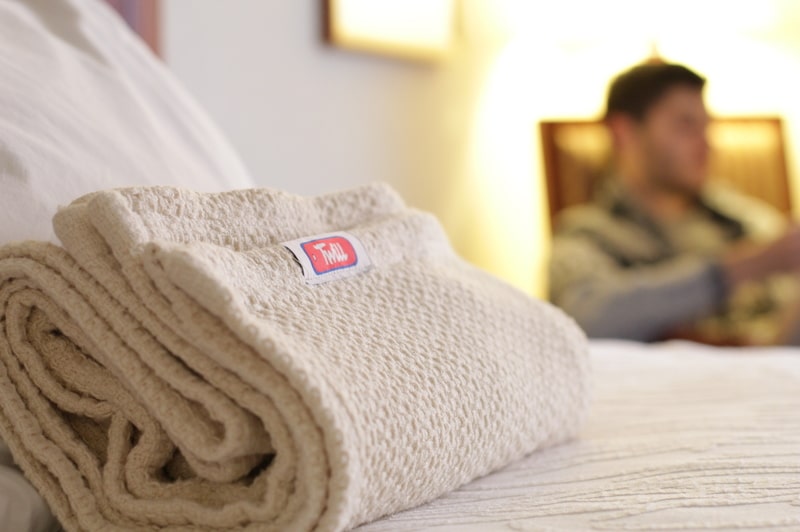Woven blankets are traditionally made on looms, but have you ever thought of how to weave a blanket without a loom?

Yes, it is possible! Here is a guide to help you out.
A Step-By-Step Guide On Weaving Without A Loom
Here are a few easy steps you can follow whether you are a beginner or a pro.
Step #1. Measure your materials
Before you can begin weaving, you have to set up your base by measuring your materials. Start by measuring out your threads to an appropriate length. Keep in mind that these threads will be tied in a knot, so measure more than twice the length you want your blanket to be.
Taking a few strings, find the middle of the thread, and tie a large knot, forming a loop. This is where you will hang your weave, with the strings serving as warp threads.
Step #2. Secure the warp threads
Set up your warp structure by laying out the warp threads in a flat row, ensuring that the strings are kept in their relative order.
Step #3. Knot and tuck strings in a weave
Take a thin string and tie it to the first warp string, creating a double knot, similar to the ones you use in making friendship bracelets. Leave a bit of tail that you can tuck in later.
Following this, take the thin string and, using the next warp thread, lay the string over to make a triangle, crossing to the next warp thread in shape like the number 4. After crossing the string under through its loop, pull upward. Repeat this step until you go through all the loops.
If you find that your knots are crooked, push them up or down to make them straight and balanced.
When you’re done, you will have a row of knots across the warp threads that will hold the weave together.
Step #4. Secure the weave
When you’re done weaving, take your end threads and bring them to the back of the weft threads. Tuck both the top and bottom threads into the weft threads and make sure that they are not visible through the front of your weave.
Step #5. Stitch smaller weaves together to create your blanket
Weaving large pieces can be cumbersome, so you may opt to weave smaller squares and sew them together to make your blanket, similar to quilting.
Alternative Ways On How To Weave A Blanket Without A Loom
Blankets are generally made on looms, but you can use alternative means to complete your project if you don’t have one. Here are some ways you can make your blanket.
-
Weave smaller squares
Like quilting, you can make smaller woven squares to sew together to make your blanket. This way, you can save some space in your work area without having to compromise the quality of your blanket.
-
Build a DIY loom
Blanket looms can be as big as you want them to be, so if you plan to keep weaving as a hobby, you may invest some time making your loom using simple building materials. For this, you will need some lumber, brackets, some wood glue, wood screws, and corner brackets.
-
Use easy-weave large threads
If you want a cozy blanket with looser weaves, you can lay your warp on a table and weft between them. Make sure that you have enough space to make your blanket as you lay things out—tape down the ends of your warp yarn to make weaving easier. Chunkier yarns work best for this kind of project.
-
Opt to hand-knit
Hand-knitting is also a great way to make a soft, chunky blanket. While it is not exactly weaving, you can create a similar outcome by creating a loops’ chain pattern using your hands. Use soft-looped yarn made specifically for knitting blankets. These are soft materials that come in many different colors to make a blanket befitting your personality.
What are the terminologies you need to know before weaving?
Starting a new hobby can be overwhelming, especially when, like weaving, it comes with many new terminologies for you to become familiar with. Here are some words that you may come across when starting your weaving hobby.
- Beater – Also called batten, this is the swinging or sliding frame that holds the reed. It is used to beat the weft in place.
- Fell – This is the spot in the woven cloth where the most recent weft pick is located or placed.
- Plain Weave – This is the basic structure you can use by interlacing a weft thread over and under every other warp end and using the reverse pattern (under and over) in the next pick.
- Warp – These are the vertical threads that run the length of the loom.
- Weft – The horizontal threads interlace the warp, creating the woven cloth.
Conclusion
Like many other crafts, weaving can be complicated at first, but you will eventually learn as you go. Depending on how much you want to pursue it as a craft, you can start with simple projects that you can make in front of the television – to bigger, more complex ones that require more materials and larger spaces. Now that you know how to weave a blanket without a loom, you can be flexible and creative in achieving your goals, so have fun discovering this fun craft.
